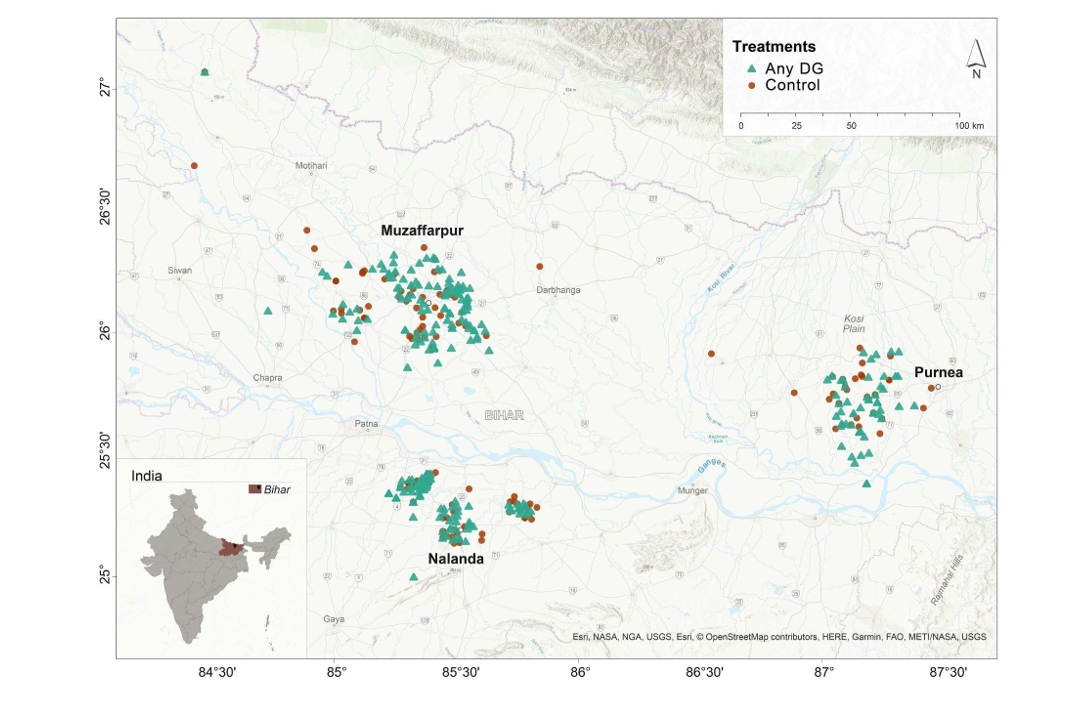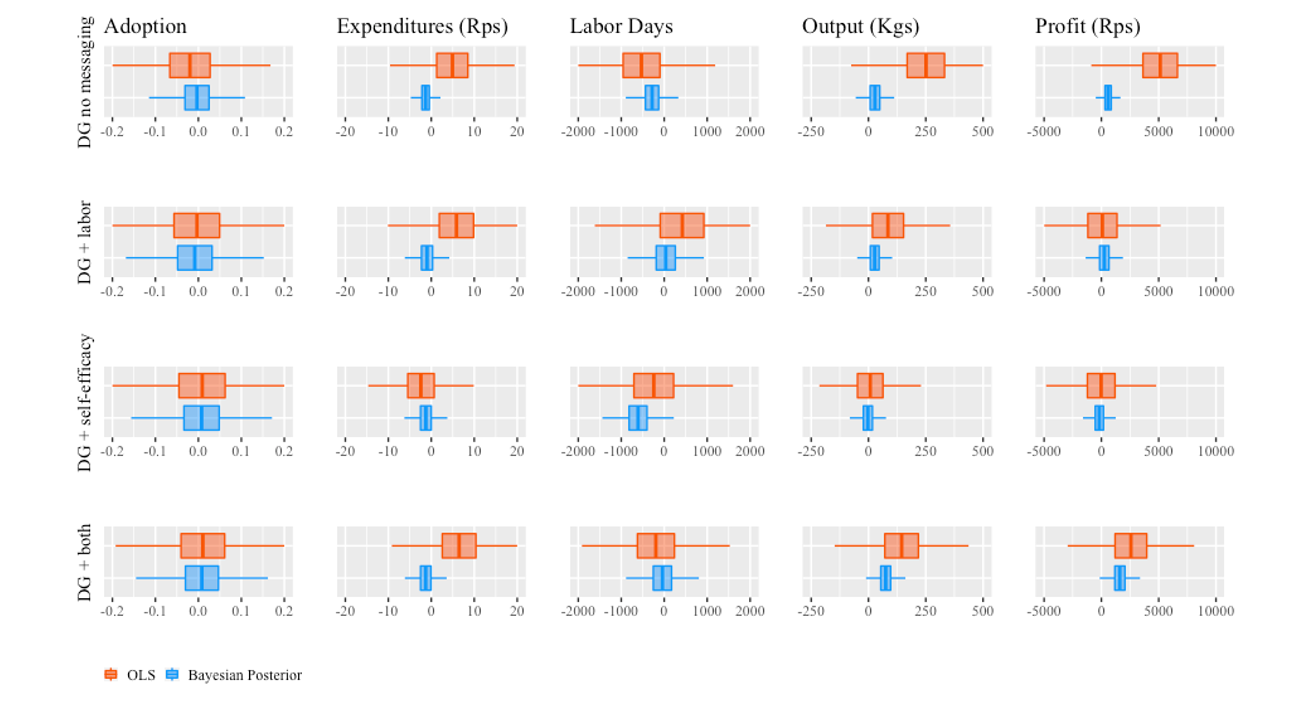
Video aids tailored to their context and shown repeatedly can improve outcomes for hard to reach female farmers in India
To enhance the productivity of difficult-to-reach farmers, extension training is essential (Takahashi et al 2020, Norton and Alwang 2020). While extension training typically takes the form of one-time events, effective learning requires repetition, not just good content, to effectively transfer information. Learning also happens best when students’ reservations and insecurities are addressed. In person mediated videos are a medium that can deliver on both of these fronts at a low cost by providing consistent, repeatable content and by addressing specific farmer concerns in an engaging way.
We worked with a large NGO called Digital Green (DG), which, to date, has reached approximately 5.6 million farmers with its video aids. The videos in the study introduced a valuable, but sometimes difficult to implement, climate smart technique for cultivating rice - System Rice Intensification (SRI). SRI helps farmers improve productivity while reducing their dependence on water. It is a multi-step process, which can elicit reservation in farmers, both because there is uncertainty about much more work it requires over traditional rice cultivation, and because its success has been demonstrated primarily on scientific trial plots, as opposed to real world smallholder farmers’ plots.
In a four-arm randomised controlled trial (RCT) we introduce video training layered on top of standard extension training provided by the National Rural Livelihood Missions Program in Bihar, India (Baul et al. 2024). By introducing videos into extension training, we aimed to enhance, rather than replace, the quality and effectiveness of traditional extension services in a low-cost way. A main video provides the key steps of implementing SRI, while three additional treatment arms address farmer specific concerns with SRI: a message that addresses the labour needed to implement SRI; a message that addresses the ability and experience of an average farmer in implementing SRI; and a message that incorporates both of the latter.
Context
We conducted the study in Bihar, India, with female farmers from reserved classes. Bihar is one of the poorest states in India, with a per capita GDP of 28,317 Rps (440 USD) per year and low literacy rates (69% for males and 49% for females), highlighting the need for accessible extension methods. Many of the latest extension trials use short wave messaging (SMS), which requires that farmers own their own phones and are literate, but this can exclude female farmers who may not own their phones and who are less likely to be literate. Further, social norms can prevent training from reaching women from reserved classes (Krishna et al. 2019). However, with video, we could select women who had similar backgrounds to the farmers receiving training.
Figure 1: The geographic distribution of this RCT

Methods
In estimating the effects of the RCT on farmers' output and profits, we faced a common challenge with agricultural data - fat tails (Okorie et al. 2023), which is data with a high frequency of outliers. This means there were more extreme results than we usually expect. This could be caused by errors in how we measured things, differences among the farmers, or the varied effects of the methods we used. Estimating the average effects of our tests required that the data follow a normal distribution with narrower tails than what we observed. To address this, we used a mix of techniques that could account for the data patterns: quantile regressions, weighted quantile regression, and a Bayesian hierarchical model, giving us a more accurate understanding of the effects of our intervention.
The first (quantile regressions) helped us understand how different segments of the outcomes (labour, farm expenditures, output, yield, and profits) are affected by our intervention. The second (weighted quantile regression) helped us confirm where our quantile treatment effects are least reliably estimated. The third (Bayesian hierarchical model) provides insights into the entire probability distribution of treatment effects, accounting for the data generating process of the data.
Results
First, we estimate the simple average effects (average treatment effects, “ATE”, a common way to estimate programme impacts in economics) and find economically large and positive effects for output and yields, a 19-20% increase when pooling all treatment arms, and 30-40% for the main DG arm that had no additional messaging regarding labour or self-efficacy (we call this main arm - DG no messaging). But the effects are imprecisely estimated (ATE may be overly sensitive to outliers for capturing the essence of the impact, thus the fat tails are distorting our understanding of the impact of the videos).
The other methods we employ help us uncover a more precise picture of who the programme helped in our sample. Quantile regressions and weighted quantile regression show that the effects in the lower quantiles (25-50% quantiles), i.e. for farmers at lower levels of output, are statistically meaningful and more precisely estimated showing increases ranging from 3 to 18%. Conversely, the effects in the upper quantiles are imprecisely estimated, particularly for output. This is why the ATE is large and imprecisely estimated.
The Bayesian Hierarchical model also points to non-zero effects on output and yields, and the effect sizes are in the order of the quantile effects for the 25-50% quantiles. What this triumvirate of models helps undercover is that the precision with which we can estimate effects of our intervention differ along the distribution of outcomes, and an average treatment effect can obfuscate programme effects if for parts of the data it is difficult to get a precise point estimate.
In the below figure each boxplot represents the treatment effect for each treatment arm on the outcomes using a Bayesian model with weak priors versus OLS. If we narrow in on output in terms of kilograms per farm, we can see the large difference between the average treatment effect from OLS in orange with a wide confidence interval and the smaller effects estimated by the Bayesian Hierarchical in blue.

Notes: For the Bayesian model, the thin line covers the central 95% posterior interval; the box covers the central 50 percent posterior interval; and the vertical bar within the box marks the posterior mean. For the OLS, the thin line covers the standard 95 percent confidence interval; the box covers a 50 percent confidence interval computed in the same way; and the vertical bar within the box marks the mean of the posterior.
Our additional analysis also shows another important result when we look beyond average treatment effects; the most promising effects are coming from the sub-treatment with both additional messages. We argue that the two messages work in tandem. The labour message prepares farmers for the reality of the labour requirements, while the self-efficacy message helps participants feel capable of implementing the technique.
Conclusion
Individuals learn best when they can see and hear information more than once, and when their questions and concerns about what they’re learning can be answered. However, agricultural extension typically can only offer one time demonstrations.
We show, using several statistical methods, that video aids tailored to their context and shown repeatedly can improve outcomes for hard to reach female farmers in India. We go beyond estimating average treatment effects to understand that the benefits of these aids accrue to individuals with lower starting output, and that including messages addressing farmers’ concerns of labour costs and messages supporting the self-efficacy of farmers further improved their output. Lastly, we demonstrate that the added per farmer marginal profits gained from the intervention outweigh the marginal cost, regardless of which outcome we use to measure (output per farm or output per acre) the programme’s effects.
References
Baul T, D Karlan, K Toyama and K Vasilaky (2024), “Improving Smallholder Agriculture via Video-Based Group Extension.” Journal of Development Economics, forthcoming.
Norton, G W and J Alwang (2020), “Changes in Agricultural Extension and Implications for Farmer Adoption of New Practices.” Applied Economic Perspectives and Policy, 42: 8-20. https://doi.org/10.1002/aepp.13008
Okorie, I E, E Afuecheta, and S Nadarajah (2023). “Time series and power law analysis of
crop yield in some east African countries.” PLOS One. https://doi.org/10.1371/journal.pone.0287011
Takahashi K, R Muraoka, and K Otsuka (2020), “Technology adoption, impact, and extension in developing countries’ agriculture: A review of the recent literature.” Agricultural Economics, 51: 31–45. https://doi.org/10.1111/agec.12539



